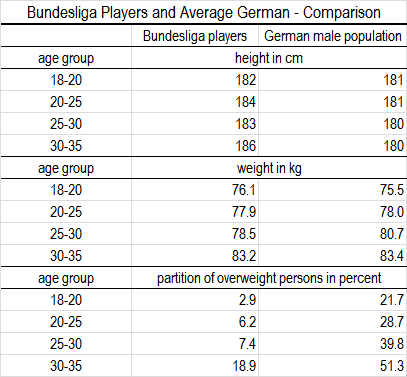So recently I came across that wonderful website whoscored.com, which offers a great database with a lot of player and team data far beyond the information usually available. Having dealt with football data on the aggregate level of leagues before, I thought it might be a good idea to take a closer look on some features to gain some insights on the micro level of the game. So here I am, digging into some of the data I scraped from the website.
Wondering which hypothesis I could go after, it crossed my mind that I could start with the basics. What can be said about the body physics of professional football players? How can they be compared to the German average?
I plotted weight and height of all the Bundesliga players and enriched the diagram with additional lines representing the edges of Body Mass Index (BMI) zones. The BMI is calculated by dividing the weight in kg by the square of the height in meters. It is used to measure the physical condition of people or societies under consideration of their height.
Marco Reus, you and me
Not surprising there is a strong correlation (Pearson’s r = 0.82) between height an weight, with an average of 183.7 cm and 78.6 kg. Compared to the average male German, Bundesliga players are more than 5 cm taller (1.78 cm) and nearly 5 kg lighter (83.4 kg), if the whole male population is included. These metrics are of course biased, because older people tend to be smaller and heavier, at least until they get into their 60s. The following table compares the physics of Bundesliga players to average German males in their respective age groups. The data are from chapter four of Statistisches Jahrbuch 2012.

Comparison of height, weight and overweight percentage of Bundesliga players and average German males
While there is almost no difference regarding the weight of both groups, the professional players tend to be a few centimeters taller. In the group of the players between 30 and 35, the difference is 6 cm. The main reason for this: More than 22 percent of the players in this age group are goalkeepers who tend to have a longer career and are taller than other players.
Regarding the BMI, the majority of players is located in the normal weight zone with a tendency towards the upper edge. According to the BMI criteria, only a few players can be classified as slightly overweight. It’s improbable that any of them are fat. I think the more plausible reason some of them are hitting the overweight zone is their high share of muscle tissue. The BMI doesn’t make any any differences between fat and muscles. Compared to average males, the percentage of overweight football players is rather small.
The final conclusion this far: Bundesliga players have average weight for their age groups, but are slightly taller. Only a small share of them is overweight by BMI criteria.
What else can be done with body data?
As the goalkeeper example has shown, some positions seem to have special demands for the body measurements of players. I’ll soon write a follow up post that will deal with this relation. Finally there probably is also a connection between average body height an the performance of teams. Have a look at this blog post by Chris Anderson which suggests a strong correlation between the average height of a population and the FIFA coefficient of its national team.
by Tobias Wolfanger


